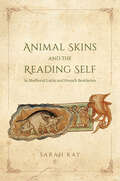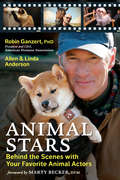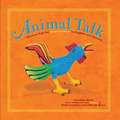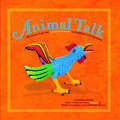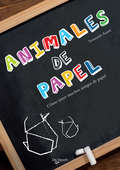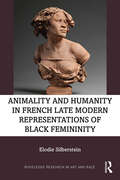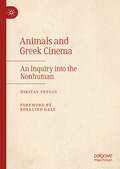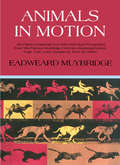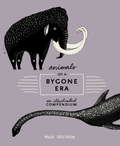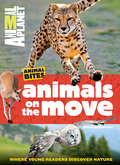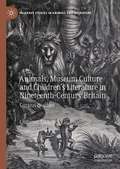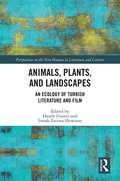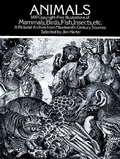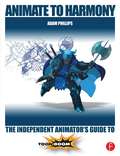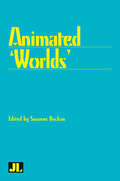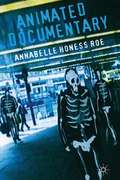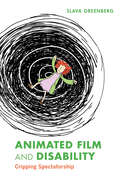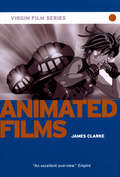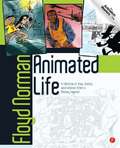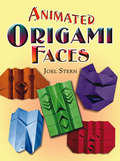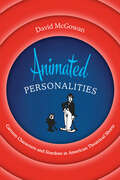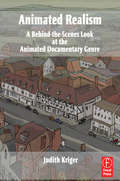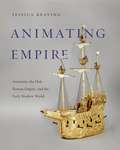- Table View
- List View
Animal Skins and the Reading Self in Medieval Latin and French Bestiaries
by Sarah KayJust like we do today, people in medieval times struggled with the concept of human exceptionalism and the significance of other creatures. Nowhere is this more apparent than in the medieval bestiary. Sarah Kay’s exploration of French and Latin bestiaries offers fresh insight into how this prominent genre challenged the boundary between its human readers and other animals. Bestiaries present accounts of animals whose fantastic behaviors should be imitated or avoided, depending on the given trait. In a highly original argument, Kay suggests that the association of beasts with books is here both literal and material, as nearly all surviving bestiaries are copied on parchment made of animal skin, which also resembles human skin. Using a rich array of examples, she shows how the content and materiality of bestiaries are linked due to the continual references in the texts to the skins of other animals, as well as the ways in which the pages themselves repeatedly—and at times, it would seem, deliberately—intervene in the reading process. A vital contribution to animal studies and medieval manuscript studies, this book sheds new light on the European bestiary and its profound power to shape readers’ own identities.
Animal Stars
by Allen Anderson Robin GanzertWhen cameras roll and directors call, "Action," some of the most dependable, funniest, and most enthusiastic actors stand poised on four legs, with ears alert. From Joey in War Horse to the wolves in Game of Thrones, what we see on screen is the result of meticulous preparation and professional teamwork. The eye-popping, heartwarming stories in these pages reveal the trainers, actors, directors, and, of course, dogs, cats, horses, penguins, deer, and other animals in all their behind-the-scenes glory. You'll discover that some animal actors have diva tendencies and others have rags-to-riches backstories. American Humane Association certified animal safety representatives work carefully to ensure that no animals are harmed, as they have been doing for decades. Animal stars have done it all -- convinced us to eat more tacos, broken our hearts in war dramas, inspired us with enduring love and loyalty, kept us at the edge of our seats as they snarled in the shadows, mirrored human antics to make us roar with laughter, and, like Uggie (from The Artist), stolen the show on the red carpet. Who besides a monkey named Crystal could impress a brilliant comedian like Robin Williams in Night at the Museum? And animal stars will work for food, including only KFC original recipe for Casey the bear -- no other fried chicken will do! These charming and sometimes hilarious stories will give you a new appreciation for the skill and patience it takes to teach nonhuman actors to perform on camera. Training tips from the pros and personal recollections of celebrities such as Julia Roberts, Hailee Steinfeld, and Steven Spielberg make this insider's look at the lives and work of these incomparable stars as irresistible as the animals themselves. A portion of the publisher's proceeds from this book will aid American Humane Association.
Animal Talk: Mexican Folk Art Animal Sounds in English and Spanish (First Concepts in Mexican Folk Art)
by Cynthia WeillDid you know that animals that live in one country don't always talk the same language as animals from somewhere else? Take a rooster, for instance. In English-speaking countries, he says cock-a-doodle-doo when he has a notion to announce himself or to greet the dawn. But in Spanish-speaking countries, he says ki-kiri-ki. Emerging readers will delight in identifying the animals depicted on each new page. And the bilingual text invites parent and child into an interactive and playful reading experience for acting out animal sounds in English and Spanish. <p>Craftsman Rubí Fuentes and Efraín Broa from the Mexican state of Oaxaca fill the pages of Animal Talk with vibrant, wildly imaginative figures of familiar animals. Animal Talk is the fifth book in Cynthia Weill's charming First Concepts in Mexican Folk Art series. It is her passion to promote the work of artisans from around the world through early concept books.
Animal Talk: Mexican Folk Art Animal Sounds in English and Spanish (First Concepts in Mexican Folk Art)
by Cynthia WeillFrom Oaxaca, Mexico, come vibrant wood carvings of animals that invite children to learn animal sounds in English and Spanish. Desde Oaxaca, México, vienen vibrantes tallados en madera de animales que invitan a los niños a aprender los sonidos de los animales en inglés y español.Did you know that animal noises can sound different in different languages? A goat greets you with "meh, meh" in English and "bee bee" in Spanish. And in English a rooster calls out "cock-a-doodle-doo" to greet the dawn, while a rooster loudly crows "ki-kiri-ki" in Spanish. Young readers will delight in identifying the fifteen imaginative figures of familiar animals in this charming bilingual book, while the text invites children to imitate animal sounds in English and Spanish. This is the perfect book for an interactive and playful beginning reading experience. ¿Sabías que los ruidos de los animales pueden sonar diferentes en diferentes idiomas? Una cabra te saluda con "meh, meh" en inglés y "bee bee" en español. Y en inglés, un gallo grita "cock-a-doodle-doo" para saludar al amanecer, mientras que un gallo canta en voz alta "ki-kiri-ki" en español. Los lectores jóvenes se deleitarán al identificar las quince imaginativas figuras de animales familiares en este encantador libro bilingüe, mientras que el texto invita a los niños a imitar los sonidos de los animales en inglés y español. Este es el libro perfecto para una experiencia de lectura inicial interactiva y lúdica.
Animales de papel
by Emanuele AzzitàUna hoja de papel cualquiera en tus manos y el libro abierto; lee las instrucciones, mira los dibujos y dobla el papel, despacito y con cuidado... verás que, como por arte de magia, ¡la hoja de papel ha desaparecido y tienes ante ti un cisne! (o una rana o el animal que hayas elegido). Así de fácil y de divertida es la papiroflexia. Si practicas con frecuencia, lo harás cada vez mejor y, si además utilizas papeles de colores distintos o pintas tus obras con lápices de colores, pronto podrás tener los animales de tu propio zoo, de tu granja o de tu selva. La papiroflexia es una actividad muy fácil de practicar que, sin más gastos, procura grandes momentos de diversión, y que el padre y la madre podrán compartir con sus hijos e hijas. Ayuda a desarrollar la habilidad manual, la imaginación y la creatividad; mejora la autoestima de los niños y niñas que comprueban que son capaces de crear sus propios juguetes. Usted puede también enseñarles a reciclar el papel usado para sus juegos a la vez que los aleja de la televisión y otras pantallas electrónicas. Emanuele Azzità es un gran experto en papiroflexia que ha publicado varias obras sobre este tema en Editorial De Vecchi. En esta ocasión, se ha propuesto presentar graciosos proyectos, apropiados para los más jóvenes de la casa.
Animality and Humanity in French Late Modern Representations of Black Femininity (Routledge Research in Art and Race)
by Elodie SilbersteinThis volume examines the evolution of the depictions of black femininity in French visual culture as a prism through which to understand the Global North’s destructive relationship with the natural world. Drawing on a broad spectrum of archives extending back to the late 18th century – paintings, fashion plates, prints, photographs, and films – this study traces the intricate ways a patriarchal imperialism and a global capitalism have paired black women with the realm of nature to justify the exploitation both of people and of ecosystems. These dehumanizing and speciesist strategies of subjugation have perpetuated interlocking patterns of social injustice and environmental depletion that constitute the most salient challenges facing humankind today. Through a novel approach that merges visual studies, critical race theory, and animal studies, this interdisciplinary investigation historicizes the evolution of the boundaries between human and non-human animals during the modern period. The book will be of interest to scholars working in art history, visual studies, critical race theory, colonial and post-colonial studies, animal studies, and French studies.
Animals and Greek Cinema: An Inquiry into the Nonhuman
by Nikitas FessasThis book offers a non-anthropocentric account of a national cinema. Drawing on cutting-edge developments in Animal (film) studies, the book gathers a wide range of species and genres to discuss the Greek cinematic animal. This en-tails recalibrating the readers&’/viewers&’ gazes to include particular nonhumans, often displaced in the frame&’s margins. While acknowledging the cost paid in animal suffering for Greek cinema to rise, the book features instances of animal-human bonding. Combining close readings with interviews with directors, human actors, screenwriters, cinematographers, producers, special effects artists, and animal wranglers, this book proposes a paradigm of human-animal praxis, arguing that revisiting nonhuman images can lead to renewed ethical relations, and to less speciesist cinemas, film industries, and societies.
Animals in Art
by Jessica RawsonAnimals have been the subject of art from the time that man started to draw, engrave and carve. They have been and are almost as important to men as man himself. In many societies and at many periods animals have been the most prominent subject of art. But this art shows much more varied attitudes to animals than those we today at first expect. In modern urbanised society we look on most animals from a distance. This distance is not bridged by the great extent of our modern scientific knowledge.
Animals in Motion
by Eadweard Muybridge"The dry plate's most spectacular early use was by Eadweard Muybridge." -- Life"A really marvelous series of plates." -- Nature (London)"These photographs have resolved many complicated questions." -- Art JournalHere is the largest, most comprehensive selection of Muybridge's famous animal photos -- more than 4,000 high-speed shots of 34 different animals and birds, in 123 different types of actions. Animals are shown walking, running, leaping, flying -- in typical actions. The horse alone is shown in more than 40 different ways: galloping with nude rider, trotting, pacing with sulky, cantering, jumping hurdles, carrying, rolling on barrels, and 36 other actions. All photos taken against ruled backgrounds; most actions taken from 3 angles at once: 90 degrees, 60 degrees, rear. Foreshortened views are included. These are true action photos, stopped in series, taken at speeds up to 1/2000th of a second. Actions are illustrated in series, with as many as 50 shots per action. Muybridge worked with the University of Pennsylvania for three years, made more than 100,000 exposures, and spent more than $50,000. His work has never been superseded as a lifetime reference for animators, illustrators, artists, and art directors.
Animals of a Bygone Era: An Illustrated Compendium
by Maja SäfströmA beautifully illustrated collection of fascinating, surprising, and funny facts about extinct animals.In the past, amazing and strange animals roamed the earth, including giant sea scorpions, tiny horses, enormous sloths, and fierce "terror birds." These and many more fantastic extinct animals are illustrated in this whimsical collection by Swedish artist Maja Säfström.
Animals on the Move (Animal Bites Ser.)
by Dorothea Di PriscoWith more than 200 gorgeous photos of animals in their natural habitats, there's action and adventure on every page of Animals on the Move. This fast-moving addition to the Animal Bites series provides kids in the first years of schooling with the perfect bite-sized view of their favorite animals. Arranged thematically with a focus on animal behavior and family relationships, young readers will explore sections about migration, fast and slow, hunting and playing, and animal movement on land, in the air, and in water, Special book features designed for this age group include simple graphics and 'Just Like Me' sidebars with fascinating animal facts for young readers to learn more about themselves and the amazing animals that share our world.
Animals, Museum Culture and Children’s Literature in Nineteenth-Century Britain: Curious Beasties (Palgrave Studies in Animals and Literature)
by Laurence TalairachAnimals, Museum Culture and Children’s Literature in Nineteenth-Century Britain: Curious Beasties explores the relationship between the zoological and palaeontological specimens brought back from around the world in the long nineteenth century—be they alive, stuffed or fossilised—and the development of children’s literature at this time. Children’s literature emerged as dizzying numbers of new species flooded into Britain with scientific expeditions, from giraffes and hippopotami to kangaroos, wombats, platypuses or sloths. As the book argues, late Georgian, Victorian and Edwardian children’s writers took part in the urge for mass education and presented the world and its curious creatures to children, often borrowing from their museum culture and its objects to map out that world. This original exploration illuminates how children’s literature dealt with the new ordering of the world, offering a unique viewpoint on the construction of science in the long nineteenth century.
Animals, Plants, and Landscapes: An Ecology of Turkish Literature and Film (Perspectives on the Non-Human in Literature and Culture)
by Hande Gurses Irmak Ertuna HowisonThe landscape of Turkey, with its trees and animals inspires narratives of survival, struggle and escape. Animals, Plants, and Landscapes: An Ecology of Turkish Literature and Film, will be the first major study to offer fresh theoretical insight into this landscape, by offering a collection of analyses of key texts of Turkish literature and cinema. Through discussion of both classical and contemporary works, this volume, paves the way for the formation of a ecocritical canon in Turkish literature and the rise of certain themes that are unique to Turkish experience. Snakes, fishermen and fish who catch men, porcupines contemplating on human agency, dogs exiled on an island and men who put dogs to fights, goat herders and windy steppes of Anatolia are all agents in a territory that constantly shifts. The essays included in this volume demonstrate the ways in which the crystallized relations between human and non-human form, break, and transform.
Animals: 1,419 Copyright-Free Illustrations of Mammals, Birds, Fish, Insects, etc (Dover Pictorial Archive)
by Jim HarterSelected for its visual impact and ease of use, this outstanding collection of wood engravings presents over 1,000 species of animals in extremely lifelike poses. Includes many different versions of familiar mammals, birds, reptiles, amphibians, fish, insects, and other invertebrates such as spiders, crabs, squid, earthworms, and more. Captions provide modern common-name identifications.
Animate to Harmony: The Independent Animator's Guide to Toon Boom
by Adam PhillipsWant to create studio-quality work and get noticed? Just coming off Flash and looking for a Toon Boom intro? Are you a traditional pencil-and-paper animator? From scene setup to the final render, learn how to navigate the Toon Boom interface to create animation that can be published on a variety of platforms and formats. Animate to Harmony guides you through Toon Boom’s Animate, Animate Pro and Harmony programs, teaching you how to create high-quality 2D animation of all complexities. The main text focuses onfeatures that are common across all three programs while "Advanced Techniques" boxes throughout the book elaborate on Pro and Harmony features, appealing to all levels of experience with any of the three main Toon Boom products.
Animated 'Worlds'
by Suzanne BuchanWhat do we mean by the term "animation" when we are discussing film? Is it a technique? A style? A way of seeing or experiencing "a world" that has little relation to our own lived experience of "the world"? In Animated Worlds, contributors reveal the astonishing variety of "worlds" animation confronts us with. Essays range from close film analyses to phenomenological and cognitive approaches, spectatorship, performance, literary theory, and digital aesthetics. Authors include Vivian Sobchack, Richard Weihe, Thomas Lamarre, Paul Wells, and Karin Wehn.
Animated Documentary
by Annabelle Honess RoeAnimated Documentary, the first book to be published on this fascinating topic, considers how animation is used as a representational strategy in nonfiction film and television and explores the ways animation expands the range and depth of what documentary can show us about the world. On behalf of the Society for Animation Studies(SAS), the Chair of the Jury announced the book as the winner of the delayed 2015 SAS McLaren-Lambart Award with the following words: 'Animated Documentary is a vital addition to both animation scholarship and film studies scholarship more broadly, expertly achieving the tricky challenge of synthesising these two scholarly traditions to provide a compelling and brilliantly coherent account of the animated documentary form. At the heart of Roe's book is the conviction that animated documentary "has the capacity to represent temporally, geographically, and psychologically distal aspects of life beyond the reach of live action" (p. 22). As a representational strategy, Roe details how animated documentary can be seen to adopt techniques of "mimetic substitution, non-mimetic substitution and evocation" in response to the limitations of live action material (p. 26). Animated Documentary will without doubt become an essential resource for many years to come for anyone interested in the intersection of animation and documentary. '
Animated Film and Disability: Cripping Spectatorship
by Slava GreenbergWhile many live-action films portray disability as a spectacle, "crip animation" (a genre of animated films that celebrates disabled people's lived experiences) uses a variety of techniques like clay animation, puppets, pixilation, and computer-generated animation to represent the inner worlds of people with disabilities. Crip animation has the potential to challenge the ableist gaze and immerse viewers in an alternative bodily experience.In Animated Film and Disability, Slava Greenberg analyzes over 30 animated works about disabilities, including Rocks in My Pockets, An Eyeful of Sound, and A Shift in Perception. He considers the ableism of live-action cinematography, the involvement of filmmakers with disabilities in the production process, and the evocation of the spectators' senses of sight and hearing, consequently subverting traditional spectatorship and listenership hierarchies. In addition, Greenberg explores physical and sensory accessibility in theaters and suggests new ways to accommodate cinematic screenings.Offering an introduction to disability studies and crip theory for film, media, and animation scholars, Animated Film and Disability demonstrates that crip animation has the power to breach the spectator's comfort, evoking awareness of their own bodies and, in certain cases, their social privileges.
Animated Films - Virgin Film
by James ClarkeAnimation has never been so popular. The best animated films have combined the latest technology with creativity and a flair for storytelling and are adored by both children and adults. With films such as Monsters, Inc., Shrek and Toy Story capturing the imagination of moviegoers and critics, animated film is enjoying a resurgence unseen since its golden age in the 30s and 40s. From the earliest full-length feature animation, Disney's Snow White and the Seven Dwarfs, through stop-motion animation and Japanese anime to the advent of CGI, this book takes a critical look at animation through the ages and explores its infinite cinematic possibilities.
Animated Life: A Lifetime of tips, tricks, techniques and stories from a Disney Legend
by Floyd NormanA well designed, well written animated film has warmth, humor and charm. Since Steamboat Mickey, animators have been creating characters and films that are charming, warm and humorous, allowing people to connect with the animated medium. Animaton fans love the characters for a lifetime. This is the legacy of the countless animators and artists who created the classic characters and fun stories and the legacy of Disney Legend, Floyd Norman. Written with wit and verve, Animated Life is a guided tour through an entire lifetime of techniques, practical hands-on advice and insight into an entire industry. A vital tutorial in animation's past, present and future for students who are now poised to be part of another new generation in the art form. Apply artistic magic to your own projects and garner valuable insight and inspiration from a True Disney legend. With valuable advice, critical comment, and inspiration for every student of the arts, Animated Life is a classic in the making with completely relevant techniques and tools for the contemporary animation or fine arts professional.
Animated Origami Faces
by Joel SternBlending the art of paperfolding with the magic of animation, this fun and fascinating book will help origami enthusiasts at every skill level create twelve delightful faces filled with movement and life. Using ordinary letter-size paper, anyone can make lively three-dimensional faces with blinking eyes, snapping jaws, and wiggling ears:* Talking Bird* Masked Super Hero* Blowfish* Elephant* Dog* Monkey ...and more!With this simple method of paperfolding, no tools or glues are required. Just follow the easy step-by-step diagrams, accompanied by tons of helpful tips on technique, and crystal clear illustrations. An inspiring way to create homemade masks, this unique guide also includes suggestions for creating your own movable models, letting crafters mix and match features to invent new and unusual origami species!
Animated Personalities: Cartoon Characters and Stardom in American Theatrical Shorts
by David McGowanMickey Mouse, Betty Boop, Donald Duck, Bugs Bunny, Felix the Cat, and other beloved cartoon characters have entertained media audiences for almost a century, outliving the human stars who were once their contemporaries in studio-era Hollywood. In Animated Personalities, David McGowan asserts that iconic American theatrical short cartoon characters should be legitimately regarded as stars, equal to their live-action counterparts, not only because they have enjoyed long careers, but also because their star personas have been created and marketed in ways also used for cinematic celebrities.Drawing on detailed archival research, McGowan analyzes how Hollywood studios constructed and manipulated the star personas of the animated characters they owned. He shows how cartoon actors frequently kept pace with their human counterparts, granting “interviews,” allowing “candid” photographs, endorsing products, and generally behaving as actual actors did—for example, Donald Duck served his country during World War II, and Mickey Mouse was even embroiled in scandal. Challenging the notion that studios needed actors with physical bodies and real off-screen lives to create stars, McGowan demonstrates that media texts have successfully articulated an off-screen existence for animated characters. Following cartoon stars from silent movies to contemporary film and television, this groundbreaking book broadens the scope of star studies to include animation, concluding with provocative questions about the nature of stardom in an age of digitally enhanced filmmaking technologies.
Animated Personalities: Cartoon Characters and Stardom in American Theatrical Shorts
by David McGowanThis pioneering book makes the case that iconic cartoon characters, such as Mickey Mouse, are legitimate cinematic stars, just as popular human actors are.Mickey Mouse, Betty Boop, Donald Duck, Bugs Bunny, Felix the Cat, and other beloved cartoon characters have entertained media audiences for almost a century, outliving the human stars who were once their contemporaries in studio-era Hollywood. In Animated Personalities, David McGowan asserts that iconic American theatrical short cartoon characters should be legitimately regarded as stars, equal to their live-action counterparts, not only because they have enjoyed long careers, but also because their star personas have been created and marketed in ways also used for cinematic celebrities.Drawing on detailed archival research, McGowan analyzes how Hollywood studios constructed and manipulated the star personas of the animated characters they owned. He shows how cartoon actors frequently kept pace with their human counterparts, granting &“interviews,&” allowing &“candid&” photographs, endorsing products, and generally behaving as actual actors did—for example, Donald Duck served his country during World War II, and Mickey Mouse was even embroiled in scandal. Challenging the notion that studios needed actors with physical bodies and real off-screen lives to create stars, McGowan demonstrates that media texts have successfully articulated an off-screen existence for animated characters. Following cartoon stars from silent movies to contemporary film and television, this groundbreaking book broadens the scope of star studies to include animation, concluding with provocative questions about the nature of stardom in an age of digitally enhanced filmmaking technologies.&“[Animated Personalities] is impressive for its lucid historical structure and exceptionally enjoyable content . . . McGowan breathes life into celluloid figures, giving readers a backstory for some of the most enduring iconic characters of screen history. This is a truly gratifying book.&” —Choice&“Combining historical, formal, and theoretical modes of analysis, Animated Personalities represents a vital contribution to both star studies and the study of animation in classical Hollywood and beyond. By embracing a key problematic of the study of stardom―the inability to take any element of its construction as authentic―McGowan does not undermine the validity of this approach so much as craft a more honest and complete understanding of it.&” —Synoptique
Animated Realism: A Behind The Scenes Look at the Animation Tools and Techniques of Award Winning Films
by Judith KrigerWith the development and accessibility of animation tools and techniques, filmmakers are blurring the boundaries between documentary filmmaking and animation. The intimacy, imperfection and charm of the animated form is providing live-action and animation directors with unique ways to tell stories, humanize events and convey information not easily adapted for live-action media. "Animated Realism" presents animation techniques as they apply to the documentary genre with an inspirational behind-the-scenes look at award-winning animated documentaries. Animators and documentary filmmakers alike will learn how to develop a visual style with animation, translate a graphic novel into a documentary and use 3D animation as a storytelling tool, all in the context of creating animated documentaries. With insight and inspiration, "Animated Realism" includes interviews from industry luminaries like John Canemaker, Oscar Winning Director of "The Moon and the Son", Yoni Goodman, Animation Director of Oscar Nominated Waltz with Bashir and Chris Landreth, Oscan Winning creator of Ryan. Packed with beautiful, instructive illustrations and previously unpublished material (including storyboards, photos and hand-drawn sketches) and interspersed with interviews - this is an exceptional source of inspiration and knowledge for animators, students and fans alike. With a companion website featuring animated shorts from leading animated documentaries, animators, students and documentary filmmakers will be able to analyze and apply Oscar-winning animation techniques to their own films. Learn from the best...Judith Kriger interviews some of the most innovative and inspirational animators, including John Canemaker, Oscar Winning Director of "The Moon and the Son", Yoni Goodman, Animation Director of Oscar Nominated Waltz with Bashir and Chris Landreth, Oscan Winning Director of Ryan.
Animating Empire: Automata, the Holy Roman Empire, and the Early Modern World
by Jessica KeatingIn the sixteenth and seventeenth centuries, German clockwork automata were collected, displayed, and given as gifts throughout the Holy Roman, Ottoman, and Mughal Empires. In Animating Empire, Jessica Keating recounts the lost history of six such objects and reveals the religious, social, and political meaning they held.The intricate gilt, silver, enameled, and bejeweled clockwork automata, almost exclusively crafted in the city of Augsburg, represented a variety of subjects in motion, from religious figures to animals. Their movements were driven by gears, wheels, and springs painstakingly assembled by clockmakers. Typically wound up and activated by someone in a position of power, these objects and the theological and political arguments they made were highly valued by German-speaking nobility. They were often given as gifts and as tribute payment, and they played remarkable roles in the Holy Roman Empire, particularly with regard to courtly notions about the important early modern issues of universal Christian monarchy, the Reformation, the Counter-Reformation, the encroachment of the Ottoman Empire, and global trade.Demonstrating how automata produced in the Holy Roman Empire spoke to a convergence of historical, religious, and political circumstances, Animating Empire is a fascinating analysis of the animation of inanimate matter in the early modern period. It will appeal especially to art historians and historians of early modern Europe.E-book editions have been made possible through support of the Art History Publication Initiative (AHPI), a collaborative grant from the Andrew W. Mellon Foundation.
